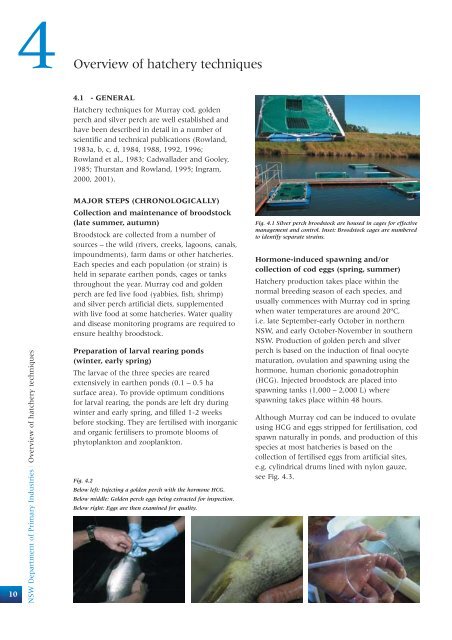Hatchery Quality Assurance Program - NSW Department of Primary ...
Hatchery Quality Assurance Program - NSW Department of Primary ...
Hatchery Quality Assurance Program - NSW Department of Primary ...
You also want an ePaper? Increase the reach of your titles
YUMPU automatically turns print PDFs into web optimized ePapers that Google loves.
4 Overview<br />
<strong>of</strong> hatchery techniques<br />
4.1 - GENERAL<br />
<strong>Hatchery</strong> techniques for Murray cod, golden<br />
perch and silver perch are well established and<br />
have been described in detail in a number <strong>of</strong><br />
scientific and technical publications (Rowland,<br />
1983a, b, c, d, 1984, 1988, 1992, 1996;<br />
Rowland et al., 1983; Cadwallader and Gooley,<br />
1985; Thurstan and Rowland, 1995; Ingram,<br />
2000, 2001).<br />
MAJOR STEPS (CHRONOLOGICALLY)<br />
Collection and maintenance <strong>of</strong> broodstock<br />
(late summer, autumn)<br />
Broodstock are collected from a number <strong>of</strong><br />
sources – the wild (rivers, creeks, lagoons, canals,<br />
impoundments), farm dams or other hatcheries.<br />
Each species and each population (or strain) is<br />
held in separate earthen ponds, cages or tanks<br />
throughout the year. Murray cod and golden<br />
perch are fed live food (yabbies, fish, shrimp)<br />
and silver perch artificial diets, supplemented<br />
with live food at some hatcheries. Water quality<br />
and disease monitoring programs are required to<br />
ensure healthy broodstock.<br />
10<br />
<strong>NSW</strong> <strong>Department</strong> <strong>of</strong> <strong>Primary</strong> Industries | Overview <strong>of</strong> hatchery techniques<br />
Preparation <strong>of</strong> larval rearing ponds<br />
(winter, early spring)<br />
The larvae <strong>of</strong> the three species are reared<br />
extensively in earthen ponds (0.1 – 0.5 ha<br />
surface area). To provide optimum conditions<br />
for larval rearing, the ponds are left dry during<br />
winter and early spring, and filled 1-2 weeks<br />
before stocking. They are fertilised with inorganic<br />
and organic fertilisers to promote blooms <strong>of</strong><br />
phytoplankton and zooplankton.<br />
Fig. 4.2<br />
Below left: Injecting a golden perch with the hormone HCG.<br />
Below middle: Golden perch eggs being extracted for inspection.<br />
Below right: Eggs are then examined for quality.<br />
Fig. 4.1 Silver perch broodstock are housed in cages for effective<br />
management and control. Inset: Broodstock cages are numbered<br />
to identify separate strains.<br />
Hormone-induced spawning and/or<br />
collection <strong>of</strong> cod eggs (spring, summer)<br />
<strong>Hatchery</strong> production takes place within the<br />
normal breeding season <strong>of</strong> each species, and<br />
usually commences with Murray cod in spring<br />
when water temperatures are around 20ºC,<br />
i.e. late September-early October in northern<br />
<strong>NSW</strong>, and early October-November in southern<br />
<strong>NSW</strong>. Production <strong>of</strong> golden perch and silver<br />
perch is based on the induction <strong>of</strong> final oocyte<br />
maturation, ovulation and spawning using the<br />
hormone, human chorionic gonadotrophin<br />
(HCG). Injected broodstock are placed into<br />
spawning tanks (1,000 – 2,000 L) where<br />
spawning takes place within 48 hours.<br />
Although Murray cod can be induced to ovulate<br />
using HCG and eggs stripped for fertilisation, cod<br />
spawn naturally in ponds, and production <strong>of</strong> this<br />
species at most hatcheries is based on the<br />
collection <strong>of</strong> fertilised eggs from artificial sites,<br />
e.g. cylindrical drums lined with nylon gauze,<br />
see Fig. 4.3.

















